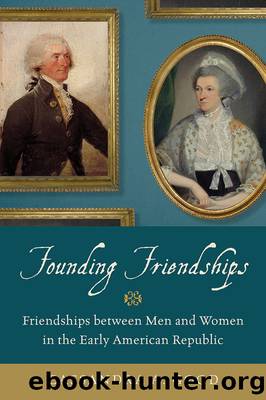Founding Friendships by Cassandra A. Good

Author:Cassandra A. Good [Cassandra A. Good]
Language: eng
Format: epub
Publisher: Oxford University Press
Published: 2014-11-19T20:20:00+00:00
FIGURE 6.11 This Vanderlyn nude may have been the artistic inspiration for Goodridgeâs Beauty Revealed. Note the similarity in the shape, size, coloration, and surrounding of white gauzy cloth. John Vanderlyn, Ariadne Asleep on the Island of Naxos, 1809â14, oil on canvas, 1878.1.11. Pennsylvania Academy of the Fine Arts, Philadelphia, Pennsylvania, gift of Mrs. Sarah Harrison (The Joseph Harrison, Jr. Collection).
Other Representations
There is one final genre of visual representation that was cheaper, easier to acquire, and more widespread than oil portraits or miniatures: the silhouette. The opacity of these outlined forms mirrors the difficulty in finding and analyzing traces of them. The exchange of silhouettes was rarely mentioned in letters and diaries, and they were much less likely to be preserved than costly works on canvas or ivory. Residents of Philadelphia and Baltimore could have silhouettes done at the Peale Museums in either city, and by folding the black paper over twice, the sitter could get four copies of his or her profile. Elsewhere itinerant silhouette makers or even prominent silhouette artists like Saint Memin could create the images in multiple copies. These could then be given to friends, family, or acquaintances in the community.43
Peale advertised his machine for creating silhouettes, the physiognotrace, as a tool for creating gifts for friends because âfriendship esteems as valuable even the most distant likeness of a friend.â Within âless than a minute,â museum visitors could get âthe truest outlines of any heretofore inventedâ to keep for themselves and give as gifts.44 Ann Ridgely, a Delaware woman visiting Philadelphia, probably had her silhouette done at the Peale Museum there, as had her circle of friends. She wrote her mother in 1803 to report that âI had my profile taken, âtis the image of me, consequently too ugly to shew. All my friends here want one, but I will not leave one behind.â She had received profiles from âa number of my acquaintance,â which she lists as including both men and women. While an accurate representation of the outlines of a face, the lack of detail and the cheapness of these images made them appropriate gifts between male/female friends.
One of the rare surviving examples of a silhouette relating to a friendship is that of Mary Roberdeau in the collection of John Quincy Adams (Figure 6.12). Adams recorded in his diary on March 4, 1829, that silhouette maker Jarvis Hanks came to his home and âcut me out and all the family in paper.â45 Included in this family group of silhouettes, all mounted on one page and labeled in Adamsâs hand, is one of his friend Mary Roberdeau. Mary must have been at the Adamsâ home frequently, as John Quincy Adams recorded in a poem to her around this time that âmany a pleasing day/Cheerâd by thy conversation I have past.â46 Her inclusion with the carefully lined-up silhouettes of Adams family members depicted her as both a friend of the family rather than just Adams, as well as showing the intimacy of that friendship. By agreeing
Download
This site does not store any files on its server. We only index and link to content provided by other sites. Please contact the content providers to delete copyright contents if any and email us, we'll remove relevant links or contents immediately.
| Americas | African Americans |
| Civil War | Colonial Period |
| Immigrants | Revolution & Founding |
| State & Local |
In Cold Blood by Truman Capote(3306)
The Innovators: How a Group of Hackers, Geniuses, and Geeks Created the Digital Revolution by Walter Isaacson(2834)
Steve Jobs by Walter Isaacson(2831)
All the President's Men by Carl Bernstein & Bob Woodward(2327)
Lonely Planet New York City by Lonely Planet(2171)
And the Band Played On by Randy Shilts(2129)
The Room Where It Happened by John Bolton;(2102)
The Poisoner's Handbook by Deborah Blum(2090)
The Murder of Marilyn Monroe by Jay Margolis(2057)
The Innovators by Walter Isaacson(2055)
Lincoln by David Herbert Donald(1943)
A Colony in a Nation by Chris Hayes(1880)
Under the Banner of Heaven: A Story of Violent Faith by Jon Krakauer(1746)
Amelia Earhart by Doris L. Rich(1648)
The Unsettlers by Mark Sundeen(1644)
Birdmen by Lawrence Goldstone(1618)
Being George Washington by Beck Glenn(1613)
Dirt by Bill Buford(1611)
Zeitoun by Dave Eggers(1590)
